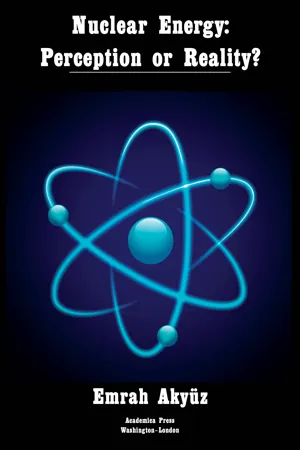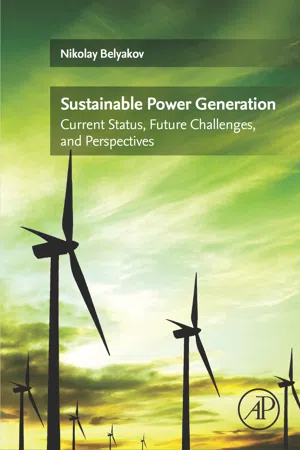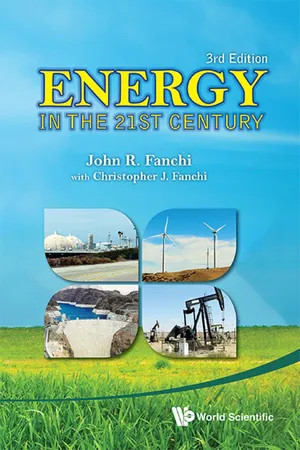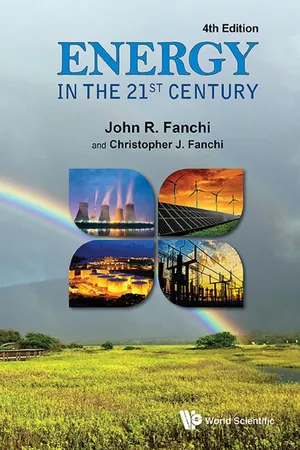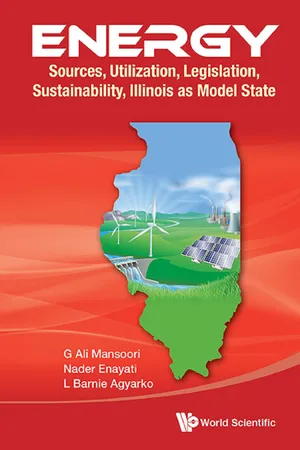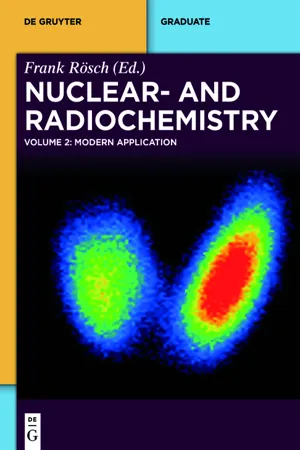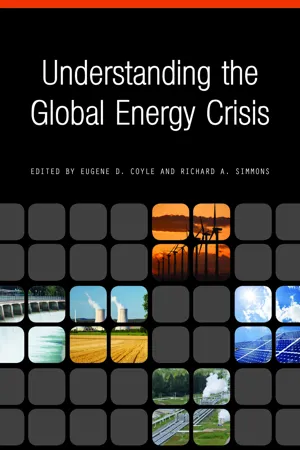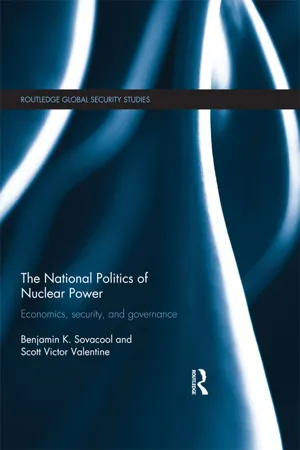Technology & Engineering
Nuclear Energy
Nuclear energy is the energy released during nuclear reactions, either through nuclear fission or fusion. In nuclear fission, the nucleus of an atom is split into smaller parts, releasing a large amount of energy. This energy is used to generate electricity in nuclear power plants, making nuclear energy a significant source of power worldwide.
Written by Perlego with AI-assistance
Related key terms
Related key terms
1 of 4
Related key terms
1 of 3
10 Key excerpts on "Nuclear Energy"
- eBook - ePub
Nuclear Energy
Perception or Reality?
- Emrah Akyüz(Author)
- 2022(Publication Date)
- Academica Press(Publisher)
2. Nuclear Energy
The term nuclear comes from the English word “nucleus.”289 The word “nucleus,” used in physics, means “the central part of an atom, usually composed of protons and neutrons,” according to the Cambridge Dictionary.290 The central part of the atom is also called the atomic nucleus. From this point of view, Nuclear Energy means atomic energy or atomic nucleus energy. In other words, Nuclear Energy is the energy source obtained from the atom. To put it more concretely, Nuclear Energy is the conversion of heat from the division of uranium by colliding with neutrons into energy.The main fuel used in nuclear power plants is uranium. Uranium, which was discovered by the German chemist Kloproth in 1789291 , can only be extracted from solid ores.292 Uranium, which is a radioactive element293 , is intensely found in saltwater sources. It is known that there are 4.5 billion tons of uranium in sea and ocean water.294 Natural uranium consists of two isotopes. The first of these is Uranium-238 (U238), which is the most abundant in nature. Since it is an indivisible isotope, it cannot be used in nuclear reactors.295 The second is Uranium-235 (U235). Today, Uranium-235 and enriched uranium are most commonly used in nuclear power plants.296 Until 2010, 2.5 million tons of uranium were mined. 2 million tons of this was used in electricity generation and the remaining 500 thousand tons were used for military purposes.297Nuclear Energy emerges as a result of the nuclear fuel cycle. The nuclear fuel cycle is a long and complex process.298 This cycle consists of three stages. The first stage is the “initial stage.” The initial stage is the process of making the nuclear fuel ready. Some of the activities done in the beginning phase are as follows; mining, conversion, enrichment, and fuel production. The second stage covers the process of generating energy from nuclear fuel. There are two basic methods used in the fuel cycle.299 The first of these methods is the once-through cycle. In this method, the uranium used in nuclear power plants is stored as waste in storage facilities. The second method is the closed fuel cycle. In this method, the plutonium formed during energy production is separated from the spent fuel and reused as fuel. The third step in the fuel cycle is the back end. The last stage covers the activities carried out after the nuclear fuel is taken from the nuclear power plant. Some of them are as follows; nuclear waste storage, nuclear waste reprocessing, and nuclear waste disposal.300 - eBook - ePub
Sustainable Power Generation
Current Status, Future Challenges, and Perspectives
- Nikolay Belyakov(Author)
- 2019(Publication Date)
- Academic Press(Publisher)
The principles of a thermal power plant, described in detail in the previous chapters, are based on the energy chain transformation that starts with the fossil fuels. These fuels can be burnt with a considerable amount of heat released during the chemical reaction. This thermal energy is further used in the steam cycle. Evidently, the chemical energy from the fossil fuels is not the only source of primary energy that can be converted into heat and thus run a similar steam cycle.The advances in nuclear physics in the 19th and the 20th centuries have brought an understanding that certain minerals can emit radioactivity — another type of energy, which can be utilized in the conversion process. When the possibility of Nuclear Energy was first recognized in the 1930s and early 1940s, it had the attraction of offering very large amounts of energy from very small amounts of material [1] . Thanks to the development of the nuclear military technology, starting in the 1940s, civil Nuclear Energy use can already claim more than half of a century history and take an honorary place in the gallery of traditional energy technologies along with thermal and hydro. Theoretically, the two major nuclear possibilities have been considered in detail: fission and fusion. The latter would be inexhaustible for all practical purposes, but developing an effective fusion system still remains an uncertain hope [1] . At present, a fission reaction is the only proven and economically feasible alternative for a civil nuclear technology.Nuclear Energy is the internal energy of the nuclear kernels, which is released under certain nuclear transformations. In nature, some heavy elements can emit radioactivity on their own meaning that there are huge amounts of energy stored inside their kernels. This effect is known as radioactive decay, which is not that common in nature. Moreover, the decay rate of this reaction is quite slow and of low efficiency. Therefore, it was the discovery of a self-sustained reaction that made it possible to increase the efficiency of energy release and utilize it for practical purposes.Each element has a number of neutrons and protons. While protons define the nucleus charge, neutrons somehow hold the positive protons within the kernel. However, if the number of neutrons is too high, then the nucleus can be unstable enough and subject to changes if exposed to the impact, and therefore is susceptible to fission. When a neutron hits the nucleus, it becomes unstable and therefore can split into two fission fragments. During this process, a few neutrons are emitted, accompanied with considerable energy release. This means that using only one neutron we can produce enough energy with extra 2–3 neutrons. These extra neutrons would in turn affect other nuclei and sustain the reaction, leading to the sustained fission reaction - Abdullah Al Faruque(Author)
- 2018(Publication Date)
- Routledge(Publisher)
Nuclear Energy is currently contributing about 17 per cent of the total global electricity production. Nuclear material and technology is also useful for medicine and agriculture. The justification for a nuclear revival has been based largely upon two policy priorities: climate change mitigation and security of energy supply. 3 Nuclear Energy is often considered a clean non-renewable energy source in terms of emissions. From an emission standpoint Nuclear Energy is more environmentally friendly than coal, oil or gas. The importance of Nuclear Energy is increasing since it is capable of meeting a significant portion of the energy needs of a country. Thus, nuclear power should be considered as one of the significant options for meeting future world energy needs at low cost and in an environmentally acceptable manner. Nuclear Energy has assumed growing significance as emission-free energy in an era of serious concern about global warming. 4 In order to improve public perception of the nuclear industry, the issue of safety and waste management need to be further developed and addressed and the industry must continue to pursue a policy of non-proliferation of nuclear weapons. Risk factors in Nuclear Energy Although nuclear technology is currently applied in diverse areas of human activity, such as medicine, nuclear research, agriculture and food preservation, the main risk stems from the generation of Nuclear Energy from the nuclear power plant. The nuclear power plant is the main part in the nuclear fuel cycle chain, and it is the place where the fission process occurs. 5 Other parts of the nuclear fuel cycle include the transportation of nuclear materials and the management and transportation of spent fuel and nuclear waste. 6 Thus, the sources include all types of nuclear facilities, such as power reactors, research reactors, nuclear fuel cycle facilities, etc, as well as medical, research and industrial sources, and defence-related sources where appropriate- eBook - ePub
- John R Fanchi(Author)
- 2013(Publication Date)
- WSPC(Publisher)
CHAPTER 5 Nuclear EnergyFossil fuels were the dominant energy source in the 20th century. Concern that the supply of fossil fuels is limited and fossil fuel combustion produces greenhouse gases is motivating the search for other sources of energy. One energy source that is receiving renewed interest is nuclear fission energy. Nuclear fission is the process in which a large, unstable nucleus splits into two smaller fragments. Energy from nuclear fission generates heat, which is typically used to generate electric power. Energy consumed by the United States included over 8% nuclear fission energy in 2010 (Appendix B) and world energy consumption was approximately 5% nuclear fission energy in 2010 (Appendix C).Nuclear Energy can be provided when large nuclei split into smaller fragments in the nuclear fission process. Energy can also be provided by combining, or fusing, two small nuclei into a single larger nucleus in the nuclear fusion process. Nuclear fusion reactions are the source of energy supplied by the sun.Both nuclear fission and nuclear fusion reactions release large amounts of energy. Significant quantities of energy need to be controlled. Some of the energy is waste heat and needs to be dissipated. Some of the energy is useful energy and needs to be transformed into a more useful form. Decay products from the fission process can be highly radioactive for long periods of time and need to be disposed of environmentally acceptable manner. On the other hand, the byproducts of the fusion process are relatively safe. The purpose of this chapter is to discuss the history of Nuclear Energy, the role of Nuclear Energy in the current energy mix, and the potential value of Nuclear Energy in a future energy mix. We begin by presenting the history of Nuclear Energy.5.1 HISTORY OF NUCLEAR ENERGYNuclear Energy became an important contributor to the global energy mix in the latter half of the 20th - eBook - ePub
- John R Fanchi, Christopher J Fanchi;;;(Authors)
- 2016(Publication Date)
- WSPC(Publisher)
CHAPTER 5
Nuclear Energy
After reading this chapter, you should be able to…Describe the discovery of the nucleusDefine radioactivityDescribe the history of nuclear powerP2P: Can we put the nuclear genie back in the bottle?Explain how nuclear fission reactors workIdentify the most common fuel for nuclear fission, and explain how it is producedExplain how nuclear fusion worksDifferentiate between nuclear fission and nuclear fusionP2P: Why is nuclear fusion so desirable?P2P: When will nuclear fusion be commercially available?Discuss the global dependence on nuclear powerDescribe the social and environmental impact of Nuclear EnergyP2P: Can nuclear waste be stored safely?P2P: Is nuclear power socially acceptable?Fossil fuels were the dominant energy source in the 20th century. Concerns about the limited supply of fossil fuels, national security, and environmental impact are motivating the search for other sources of energy. One energy source that is receiving renewed interest is nuclear fission energy. Nuclear fission is the process in which a large, unstable nucleus splits into two smaller fragments. Energy from nuclear fission generates heat, which is typically used to generate electric power. Energy consumed by the United States included over 8% nuclear fission energy in 2010 (Appendix B ) and world energy consumption was approximately 5% nuclear fission energy in 2010 (Appendix C ). Nuclear fission energy consumption is not expected to change significantly by 2020.Nuclear Energy can be provided by the fission process and the fusion process. The nuclear fission process occurs when large nuclei split into smaller fragments. Energy can also be provided by combining, or fusing, two small nuclei into a single larger nucleus in the nuclear fusion process. Nuclear fusion reactions are the source of energy supplied by the sun.Both nuclear fission and nuclear fusion reactions release large amounts of energy. Significant quantities of energy need to be controlled. Some of the energy is waste heat and needs to be dissipated. Some of the energy is useful energy and needs to be transformed into a more useful form. Decay products from the fission process can be highly radioactive for long periods of time and need to be disposed of in an environmentally acceptable manner. On the other hand, the byproducts of the fusion process are relatively safe. The purpose of this chapter is to discuss the history of Nuclear Energy, the role of Nuclear Energy in the current energy mix, and the potential value of Nuclear Energy in a future energy mix. We begin by presenting the history of Nuclear Energy. - eBook - ePub
Energy: Sources, Utilization, Legislation, Sustainability, Illinois As Model State
Sources, Utilization, Legislation, Sustainability, Illinois as Model State
- Nader Enayati, L Barnie Agyarko, G Ali Mansoori(Authors)
- 2015(Publication Date)
- WSPC(Publisher)
2 by using Nuclear Energy (NEI, 2013). As a result, it is argued that environmentally, Nuclear Energy has zero emission levels. Unlike fossil energy sources, Nuclear Energy pays for its waste disposal and decommissioning cost by including them in the actual cost of electricity. Besides, it is easily transportable because of its relatively small quantity. According to the World Nuclear Transport Institute, over several decades of transportation of nuclear materials, there has never been an in-transit accident with serious human health, economic or environmental consequences, due to the radioactive nature of the goods (WNTI, 2011). The reason is that the international transport of radioactive materials is governed by stringent regulatory guidelines, which include standards, codes and regulations that have been subjected to continuous revisions and updates over the past four decades (WNTI, 2011). However, in 1979 a core melt down of Unit 2 nuclear reactor in Three Mile Island in the U.S., caused the release of approximately 2.5 million curies of radioactive gases and approximately 15 curies of iodine-131. Also in 1986, the Chernobyl Nuclear Power Plant explosion in Ukraine, in the former Soviet Union, not only caused uncontrolled release of radioactive materials to the surrounding area, but released high levels of radiation in Europe. Furthermore, the 2011 nuclear incident in Japan caused by a tsunami undermines the sustainability of nuclear power. Economically, nuclear fuel is a highly concentrated energy source for power generation and has the advantage of being economically more attractive than other energy conversion technologies.6.8. Nuclear Fusion Reactor TechnologyNuclear power can be produced not only from fission reactions using nuclear fuels, as described above, but also from fusion reaction using, for example, hydrogen isotopes as fuel. While nuclear fusion power generation appears to be the long term solution to the world’s energy problems because of its sustainability, the technology is still in the research stage. The International Thermonuclear Experimental Reactor (ITER) project currently under construction in Cadarache, France, is envisioned to be the world’s first prototype of a nuclear fusion reactor if successful (ITERP, 2013; Wenisch et al., 2007). The nuclei of iron and nickel have the largest binding energies per nucleon, so fusion of two nuclei lighter that iron or nickel releases energy, while fusion of nuclei larger than those two absorbs energy. Thus, in principle any element lighter than iron can be used as a fuel for fusion reaction, but the ITER project in France will use deuterium and tritium as fuel (ITERP, 2013; Wenisch et al. - eBook - ePub
Encyclopedia of Chemical Processing and Design
Volume 31 - Natural Gas Liquids and Natural Gasoline to Offshore Process Piping: High Performance Alloys
- John J. McKetta Jr(Author)
- 2017(Publication Date)
- CRC Press(Publisher)
NPK Fertilizer (see Fertilizers, Mixed)Nuclear Energy I. IntroductionThis article is written to provide the reader with a basic understanding of commercial nuclear power. The basic reactions are presented schematically, along with the types of commercial nuclear reactors in the United States. In addition, nuclear safety, economics, nuclear fuel cycle, health effects of radiation, and nuclear waste disposal are discussed. Emphasis is directed to the United States commercial fission process although several statistics for worldwide commercial nuclear power are presented where appropriate. Fusion is briefly addressed.There are currently only five options for base-load electrical generation: three fossil fuel based (coal, oil, and natural gas) and two nonfossil sources (hydroelectric and nuclear). Each of these five options should be evaluated for its specific advantages and disadvantages. Recent additions of electrical generation have consisted primarily of coal and nuclear units. It is expected that future additions of electrical generation units in the United States will consist primarily of coal because of the unpredictable regulatory and licensing process for nuclear units. This topic is addressed further in the section on economics.II. Energy from the Fission ProcessWith the exception of hydroelectric, the five sources of electrical generation (coal, oil, natural gas, hydroelectric, and nuclear) require a heat source. The general schematic for an electrical generation plant is shown in Fig. 1 . Water is heated and undergoes a phase change from a liquid to steam. The energy of the steam is transformed to rotational energy in the turbine, which produces electricity by means of an electrical generator connected to it. The steam is condensed back to a liquid and is recirculated through the heat source to change phases again. Specific variations from the scheme found in Fig. 1 - eBook - ePub
- Frank Rösch, Frank Rösch(Authors)
- 2016(Publication Date)
- De Gruyter(Publisher)
Gert Langrock and Peter Zeh10Nuclear Energy
Aim: The discovery of induced nuclear fission led to many civil and noncivil applications utilizing the enormous amount of either the energy and/ or the neutrons released by nuclear fission. While military applications, such as the bombing of Hiroshima and Nagasaki and countless nuclear weapons tests demonstrated the devastating potential of nuclear fission if used for noncivil purposes, the civil use of nuclear fission created remarkable progress in scientific research and energy production.Nuclear reactors are nowadays mainly used for electricity supply. Some special reactor designs are also used for fundamental research, for the production of radionuclides, mainly for medical applications or for the production of plutonium or tritium for nuclear weapons.All reactor types are based on the use of a nuclear chain reaction where fissile material such as 235 Uor 239 Pu undergoes neutron capture reactions. This chapter continues topics described in Vol. I on spontaneous fission and on nuclear reactions, and illustrates special scientific and technological features of nuclear reactor technology.During the last decades Nuclear Energy has become an important and reliable electrical power source in many countries. The civil nuclear industry is now a multibillion business with hundred thousands of employees. Each year, new reactors are being sold, erected and connected with the grid – a good reason to have a look at some basics of Nuclear Energy production.10.1Introduction
This chapter gives a more general overview of nuclear reactors, with focus on nuclear power reactors, and some interesting aspects of the radiochemistry in light-water reactors during normal operation. It is not intended and not possible in the frame of this introductory textbook to cope with the whole field of nuclear reactor technology. Therefore, some important topics are not subjects of this chapter, e.g. detailed neutron physics and neutron balance, safety design of nuclear power plants, incidents and accidents. This chapter is an invitation to the reader to further step into the wide area of nuclear technology. - eBook - ePub
- Richard A. Simmons, Eugene D. Coyle(Authors)
- 2014(Publication Date)
- Purdue University Press(Publisher)
Climate change will increasingly factor into the determination of the future role for Nuclear Energy in national grids. Accepting that greenhouse gases are a major contributing factor to global warming, in endeavoring to avoid catastrophic consequences to the ecosystem resulting from warmer climate, it is imperative that enhanced efforts be made toward limiting the rate and pace of average global temperature increase. As discussed earlier in this book, the Kyoto Protocol has set goals to limit temperature rise to not greater than two degrees Celsius above preindustrial levels. To achieve this objective an aggressive shift from the use of carbon-emitting resources to generate energy is required. Whether such a shift is possible through introduction of renewable, non-carbon emitting fuel sources alone, is highly questionable. It is therefore essential that a wider role for Nuclear Energy be discussed between Nuclear Energy scientists, policy makers and within the broader public domain. Security of energy supply is an equally challenging and deterministic input to this debate. Energy security arguments suggest that reductions in fossil-based energy resources, which can require transportation over several thousand kilometers across land and sea boundaries, could help address over-dependence and inefficiency, factors that would have significant economic and social implications.Technological innovations in reactor design will be key to the future role for nuclear power. Evolutionary new reactor designs have made nuclear power safer and more cost-effective to currently operating plants. The adoption of advanced fuel cycle technologies will greatly relieve the pressure of waste disposal and make nuclear power a virtually sustainable resource.7.7.1. Advanced Reactors to Improve Safety and Efficiency
Since the introduction of nuclear reactors in the 1950s there have been four generations of innovation in reactor design. The first generation (I) was the early prototype reactor, developed during the 1950s and 1960s as a proof of concept design. The majority of commercial nuclear power reactors that are currently in operation belong to the second-generation (II), designed to be economical and reliable for large scale generation. Many of these reactors are nearing the end of their operational lives and will be replaced by generation III/III+ reactors, now mature following decades of research and innovation. By using state-of-the-art technologies through incorporation of over fifty years of experience, the new generation of reactors offers a major upgrade in terms of energy efficiency and operational safety. The new reactor plants are certified to operate for sixty years. Older power reactors were designed to operate for forty years.15 - eBook - ePub
- Benjamin K. Sovacool, Scott Victor Valentine(Authors)
- 2012(Publication Date)
- Routledge(Publisher)
For example, aspirations to abate CO 2 emissions associated with fossil fuel electricity generation have emerged as a key catalyst of nuclear power expansion. In reality, the nuclear power technology chain is far from CO 2 emission-free. The uranium mining process in particular can generate substantial volume of CO 2 emissions. One exploration of the greenhouse gas emissions associated with the lifecycle of nuclear power plants concluded that 38 percent come from “front-end” activities such as uranium mining and fuel enrichment (see Figure 2.4). 36 Consequently, a number of research initiatives are underway within the nuclear industry to try to minimize CO 2 emissions. As another example, growing concern over the economic costs associated with disposing spent nuclear fuel is a critical driver for investment in FBR and fusion technology. Similarly, the economics of uranium influence the type of nuclear technology that is embraced. When the cost of uranium is low, once-through technology tends to benefit; when the cost of uranium increases, closed-loop technology supplemented by fuel reprocessing tends to benefit. Figure 2.3 Erratic amplification of global oil prices (source: U.S. Energy Information Administration and Bureau of Labor Statistics). Notes May 1987–April 2011 monthly average spot prices. Conversion to April 2011 dollars uses U.S. CPI for All Urban Consumers (CPI-U). Third, changes in the economic viability of alternative energy sources also tends to influence the nuclear power technology chain in that competitively unfavorable changes reduce market prospects and somewhat dampen R&D investment within the nuclear power industry. For example, recent advances in wind power technology have in some circumstances resulted in wind power becoming an economically viable alternative to nuclear power. 37 Consequently, funds for nuclear power R&D are increasingly winding up in wind power development projects
Index pages curate the most relevant extracts from our library of academic textbooks. They’ve been created using an in-house natural language model (NLM), each adding context and meaning to key research topics.
Explore more topic indexes
Explore more topic indexes
1 of 6
Explore more topic indexes
1 of 4
